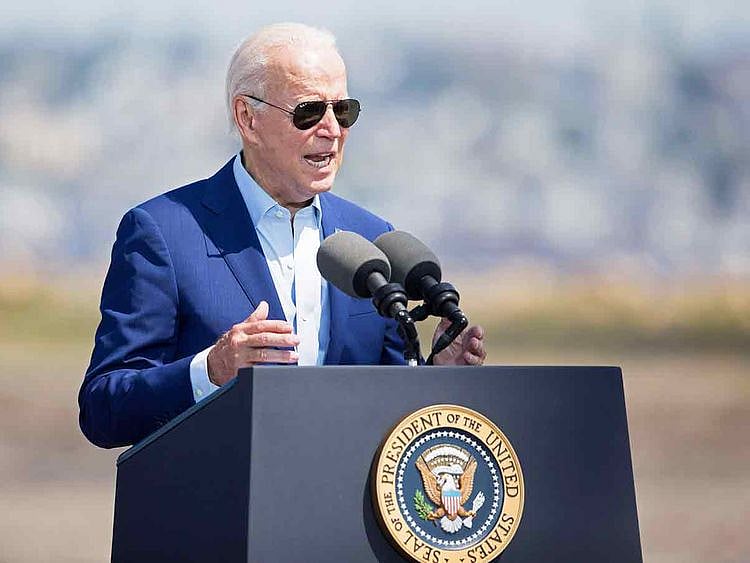In his 2020 presidential campaign, Joe Biden promised to forgive $10,000 of student loan debt for everyone, along with some complicated additional forgiveness plans for low-income borrowers and those who attended public colleges. On Wednesday, he finally made good on the promise, announcing a loan forgiveness plan meant to relieve some of the crushing $1.6 trillion in student debt Americans are carrying.
Here’s what the administration will do:
— All borrowers earning under $125,000 a year, or $250,000 for couples, will have $10,000 of their loans forgiven.
— Recipients of Pell Grants, which go to students from low-income families, will be eligible for $20,000 in forgiveness.
— The pause on loan payments and interest accumulation instituted as part of pandemic relief will be extended one final time, to the end of the year.
— Monthly payments for undergraduate loans would be capped at 5% of a borrower’s discretionary income.
Biden hasn’t exactly been in a hurry to follow through on his campaign promise; White House officials have been debating this for more than a year. But with the midterm elections approaching, they apparently concluded the time has finally come.
Let’s not pretend that as a policy question, this is anything but complicated. But here’s one thing we know: Republicans will do their best to turn this into fuel for their Resentment Industrial Complex, and Democrats would be foolhardy to let that get in the way of doing the right thing.
Let’s begin with the policy. The $10,000 figure has been Biden’s position all along, even as progressives pressed proposals to cancel up to $50,000, or even all student debt. But $10,000 would still be meaningful for a lot of borrowers, even life-changing.
According to the latest figures, that would wipe out the debt of a third of borrowers, and cut the debt of another 20% by at least half. That works out to around 24 million Americans whose lives would be profoundly aided, enabling them to pay other bills or maybe even start saving.
On the other hand, the income limit creates bureaucratic hassle; to get the loan forgiveness, you’ll have to document your income. That limit reduces the cost of the forgiveness by only a small amount, but the administration likely hoped it would mean Republicans won’t be able to label this a giveaway to the “elite.” Of course, they’re already doing this anyway.
But the number of voters who will actually understand the wonky details will inevitably be minuscule; whether there’s an income cap at $125,000, $150,000, or no cap at all will fly right over most voters’ heads. All they’ll be aware of is that Biden forgave a bunch of student loans.
And Republicans will use this issue to stoke resentment no matter what the details are. The fact that there are Democrats alive who continue to believe carefully designed policy will preclude GOP attacks is a testament to their childlike naivete. The Republican National Committee is already calling the loan forgiveness “a handout to the rich.”
A political win for Democrats?
But that doesn’t mean Republicans will succeed in persuading significant numbers of Americans to hate this idea, or that on balance it won’t still be a political win for Democrats.
The arguments are already familiar; one is aimed at people who didn’t go to college (or send their kids), and the other is aimed at people who did, but already paid off their loans. The first says, “Those fancy college graduates shouldn’t get a government handout with your tax dollars!” The second says, “You paid off your loans, so why should those people get off easy?”
In both cases, the point is to turn people against their fellow Americans, telling them to get angry about something that doesn’t actually affect them. There are few more emblematic conservative arguments than one that says you ought to be bitter and resentful if someone else who’s struggling catches a break.
But those arguments, which will be repeated endlessly in right-wing media, will probably just reinforce conservatives’ pre-existing beliefs. Student loan forgiveness is broadly popular in polls, and particularly right now it’s important for Democrats to show voters that they’re keeping promises and improving people’s lives. Even if it’s not as sweeping a plan as it could have been, this will definitely improve the lives of millions.
That being said, there’s a bigger issue here. A loan forgiveness programme like this one, for all the help it will give people in the short run, doesn’t get at the more fundamental problem, which is the high cost of a college education.
You might not be surprised to learn that Americans pay dramatically more for college than people in other countries; in places such as Germany, Denmark and Norway, tuition is free, and college in other countries features costs that to us would seem absurdly low.
College has gotten so expensive in America that the story we’ve been told — that a college education is both necessary and sufficient for success in the United States today — is increasingly being questioned.
That’s a harder problem to solve. But what the administration is doing now is at least a start.
Washington Post
Paul Waldman is an American op-ed columnist and senior writer
Sign up for the Daily Briefing
Get the latest news and updates straight to your inbox
Network Links
GN StoreDownload our app
© Al Nisr Publishing LLC 2025. All rights reserved.
